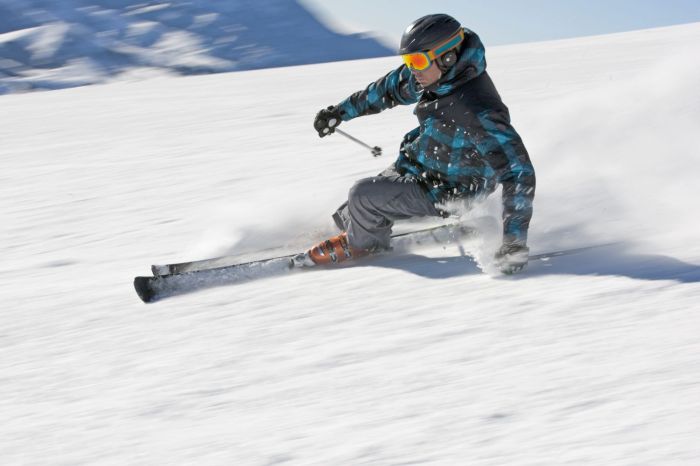In downhill speed skiing a skier – In downhill speed skiing, a skier embarks on a thrilling and exhilarating adventure, pushing the limits of human performance on snow-covered slopes. This adrenaline-fueled sport demands a unique blend of skill, precision, and courage, as skiers navigate treacherous courses at breakneck speeds.
From the specialized equipment and cutting-edge technologies that enhance safety and performance to the rigorous training regimens and mental fortitude required for success, the world of downhill speed skiing is a captivating spectacle that showcases the extraordinary abilities of human athletes.
Equipment and Gear: In Downhill Speed Skiing A Skier
Downhill skiers rely on specialized equipment and gear to achieve optimal performance and safety on the slopes.
- Skis:Downhill skis are designed for speed and stability, featuring long and wide profiles with stiff flex patterns. They are typically made from lightweight materials such as carbon fiber and titanium.
- Boots:Downhill ski boots provide support and control, with rigid shells and adjustable buckles. They are designed to transfer power from the skier’s legs to the skis.
- Bindings:Bindings connect the skis to the boots and release the skis in the event of a fall, preventing serious injuries. Downhill bindings are designed for high-speed release.
- Helmets:Helmets are essential for protecting the skier’s head from impact. Downhill helmets meet specific safety standards and feature advanced materials such as polycarbonate and expanded polystyrene.
- Protective Clothing:Downhill skiers wear protective clothing made from durable and breathable materials to withstand the rigors of the sport. This includes padded jackets, pants, and gloves.
Top brands and models used by professional downhill skiers include Atomic Redster, Salomon S/Max, and Rossignol Hero Elite.
Techniques and Skills

Downhill skiing requires a combination of fundamental techniques and advanced skills.
- Stance and Balance:The skier’s stance involves maintaining a wide and balanced position, with knees slightly bent and hips flexed forward.
- Edging:Edging is the technique of tilting the skis on their edges to control direction and speed. Downhill skiers use sharp and precise edging to navigate turns and maintain stability.
- Turning:Downhill skiers use various types of turns, including carving, skidding, and jumping. Carving involves initiating turns with an arc-like motion, while skidding involves sliding the skis sideways. Jumping is used to clear obstacles or gain speed.
- Body Positioning:Proper body positioning is crucial for downhill skiing. The skier’s weight should be distributed evenly over both skis, with the upper body leaning slightly forward.
- Timing:Timing is essential for executing turns and maneuvers. Downhill skiers must time their movements precisely to maintain control and achieve optimal speed.
Training and Practice

Downhill skiers engage in rigorous training and practice to develop their skills and endurance.
- Physical Conditioning:Downhill skiing demands excellent physical conditioning, including strength, endurance, and agility. Skiers engage in weight training, cardiovascular exercises, and flexibility drills.
- Drills and Simulations:Skiers practice specific drills to improve their technique and reaction time. These drills involve navigating obstacles, performing turns, and simulating race conditions.
- Mental Preparation:Downhill skiing requires intense mental focus and concentration. Skiers undergo mental training to develop confidence, visualization skills, and the ability to handle pressure.
Courses and Venues
Downhill ski courses are designed to challenge skiers with varying degrees of slope angles, terrain features, and obstacles.
- Slope Angles:Downhill ski courses typically feature steep slopes, ranging from 30 to 50 degrees or more.
- Terrain Features:Courses may include jumps, moguls, and other terrain features that require skiers to adapt their techniques and maintain control.
- Obstacles:Obstacles such as trees, rocks, and fences can be incorporated into courses to test skiers’ skills and reaction time.
Famous downhill ski courses include the Streif in Kitzbühel, Austria, known for its extreme slope angles and challenging jumps; and the Lauberhorn in Wengen, Switzerland, which features a 4.5-kilometer descent with a maximum slope angle of 80 degrees.
Safety and Risk Management
Safety is paramount in downhill skiing, and strict protocols and risk management measures are implemented.
- Proper Training:Skiers must undergo proper training and certification before attempting downhill skiing.
- Equipment Inspection:Equipment is regularly inspected and maintained to ensure it meets safety standards.
- Course Preparation:Courses are carefully prepared and inspected before races to minimize risks.
- Ski Patrols and Emergency Response:Ski patrols and emergency response teams are on standby to assist injured skiers and ensure safety.
Question & Answer Hub
What is the most important piece of equipment for downhill speed skiing?
Skis specifically designed for downhill speed skiing, providing stability, control, and responsiveness at high speeds.
How do skiers train for downhill speed skiing?
Through rigorous physical conditioning, drills, simulations, and practice on actual ski courses.
What are the key techniques involved in downhill speed skiing?
Stance, balance, edging, turning, carving, and jumping, all executed with precision and timing.